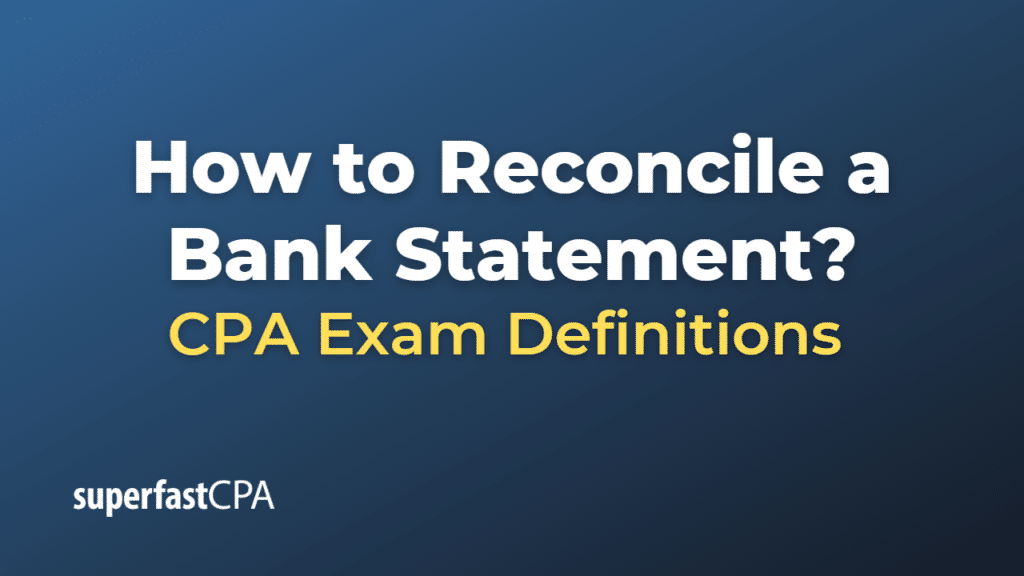How to Reconcile a Bank Statement
Bank reconciliation is a process that explains the difference between the bank balance shown in an organization’s bank statement and the corresponding amount in its own accounting records at a specific point in time.
Here’s a step-by-step guide on how to reconcile a bank statement:
- Obtain Bank Statement: Obtain the bank statement for the period you want to reconcile. The bank statement will show the account balance at the beginning and end of the period, and all the transactions that the bank has recorded.
- Obtain Your Company’s Cash Ledger: Gather your company’s cash ledger for the same period as the bank statement. The cash ledger should include all cash transactions, including checks issued, deposits, withdrawals, bank fees, etc.
- Compare Balances: Compare the ending balance on your bank statement with the ending balance in your cash ledger. If the two are equal, then no reconciliation is needed. However, if they’re different, you’ll need to identify the reasons for the discrepancy.
- Identify Outstanding Checks or Deposits: Check if there are any checks you issued that haven’t been presented to the bank yet, or any deposits you’ve recorded that the bank hasn’t processed yet. These are known as outstanding checks and deposits in transit, respectively. They are common reasons for differences between your cash ledger and the bank statement.
- Account for Bank Fees or Interest: Also, look for any bank fees or interest that the bank has recorded but you haven’t included in your cash ledger yet.
- Adjust cash ledger: Adjust your cash ledger to account for any identified outstanding checks, deposits in transit, bank fees, or interest.
- Recompare Balances: After making the adjustments, compare the adjusted balance in your cash ledger with the ending balance on your bank statement. They should now be equal. If they’re not, double-check your work and investigate any remaining discrepancies.
- Document the Reconciliation: Document your reconciliation process, including any discrepancies and adjustments made. This is an important part of maintaining accurate financial records and might be necessary for audits.
Remember that the goal of a bank reconciliation is to ensure that your company’s cash records are accurate and complete. Regularly reconciling your bank statement can help you catch errors, fraud, or discrepancies early.
Example of How to Reconcile a Bank Statement
As of the end of June 2023, your company’s cash ledger shows an ending balance of $5,000. The bank statement for the same period shows an ending balance of $4,700.
Here are the steps to reconcile the bank statement:
- Identify Outstanding Checks or Deposits: You find out that there’s one check you issued for $400 near the end of June, which has not yet been presented to the bank for payment. This is an outstanding check. There are no deposits in transit.
- Account for Bank Fees or Interest: The bank statement shows a monthly service fee of $10 that you didn’t account for in the cash ledger, and a bank interest of $20 credited to your account.
- Adjust Cash Ledger: Adjust your cash ledger to account for the outstanding check, the bank service fee, and the bank interest:
- Subtract the outstanding check ($400) and the bank service fee ($10).
- Add the bank interest ($20).
- Recompare Balances: The adjusted cash ledger balance of $4,610 now matches the bank statement balance of $4,610.
- Document the Reconciliation: Document the reconciliation, noting the outstanding check, the bank service fee, the bank interest, and the adjustments made to the cash ledger.
By following these steps, you’ve reconciled your bank statement. Even though your cash ledger initially showed a different balance than your bank statement, the reconciliation process helped you identify the reasons for the discrepancy and adjust your records accordingly. This process helps ensure that your cash records are accurate and complete.













